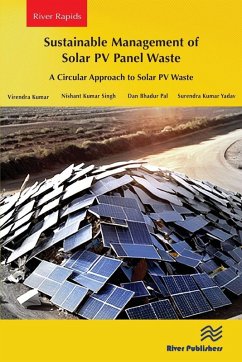Solar PV Power: Design, Manufacturing and Applications from Sand to Systems details developments in the solar cell manufacturing process, including information from system design straight through to the entire value chain of Solar PV Manufacturing. In addition, the book includes aspects of ground mounted grid connected solar PV systems and optimization for solar PV plants, economic analyses, and reliability and performance. The advances and processes of solar product technology and reliability, along with the performance of solar PV plants and operational and maintenance aspects with advance diagnostic techniques are also presented, making this an ideal resource.
With rapid change in the manufacturing process, it is crucial for solar cells and solar PV modules to adapt to new developments in solar products, especially with regard to reliability, financial aspects and performance.
With rapid change in the manufacturing process, it is crucial for solar cells and solar PV modules to adapt to new developments in solar products, especially with regard to reliability, financial aspects and performance.
"This book is not only an outstanding contribution to the understanding to solar photovoltaics from almost atoms through arrays-but its timing is perfect with the world now beyond the tipping point for implementing this electricity source. Though primarily a comprehensive technical volume servicing the exacting needs of the academic and technical communities (and it certainly does serve this important purpose), it even potentially provides the consumer and decision-maker a complete and honest overview of the art and complexity of producing solar electricity . It comes as solar photovoltaics is growing extraordinarily in world electricity markets. And at a time in which countries are looking to invest in their own manufacturing infrastructures. The understanding of the needed investments for silicon PV technology is a strength of this book. The coverage is complete, current, and state-of the art. Much of the interest might be in the manufacturing aspects (Chapters 1-5). The strength of this part of the book is that it covers the range of approaches along the PV value chain-Siemens versus fluidized-bed reactor methods for producing the feedstock, monocrystalline-Si versus multi- or polycrystalline growth of the technology base, and wafer preparation alternatives. The device physics is explored, and most important, the range of device structures is explained and evaluated for their strengths and limitations. The description of module assembly is a particular strength of this book-one can almost see the panels being assembled in the factory from cell interconnections to encapsulation, framing, and testing. The discussion of different module types is thorough-even providing insights into bifacial approaches that are now starting to dominate many markets. Quite frankly, the book would be well worth it if it had only ended here. But the authors take the PV product to the next expanses of the value chain-adding considerably to the impact and interest. Chapters 6-9 focus on systems and applications. This ranges from stand-alone through central station. The technical and economic aspects of systems are analyzed and compared-from rooftop through power plants. The balance-of-system requirements are emphasized-and the discussions of levelized cost of electricity are especially useful. The final Chapter finishes the PV coverage with an in-depth look at grid integration-certainly an aspect that represents the major markets currently. An important feature is the treatment of system reliability, degradation mechanisms, and meeting specifications. The underpinnings of proper maintenance are described-with the importance to delivering expected power and electricity cost effectiveness. The book reflects the expertise and experience of the authors who have worked in all aspects of this technology-from PV R&D through manufacturing and system development. The book is technically complete from basics through applications. It is well written. The focus is silicon technology, and has few omissions in this area which covers >90% of current markets. Thin-film technologies (e.g., CdTe, CIGS) are not covered or compared for their potential in various applications and climate conditions. " --Dr Lawrence Kazmerski, NREL (Emeritus Research Staff), University of Colorado Boulder- RASEI (Research Professor) and Fellow, Renewable and Sustainable Energy Institute (RASEI), University of Colorado Boulder, USA, Richmond, VA, USA








